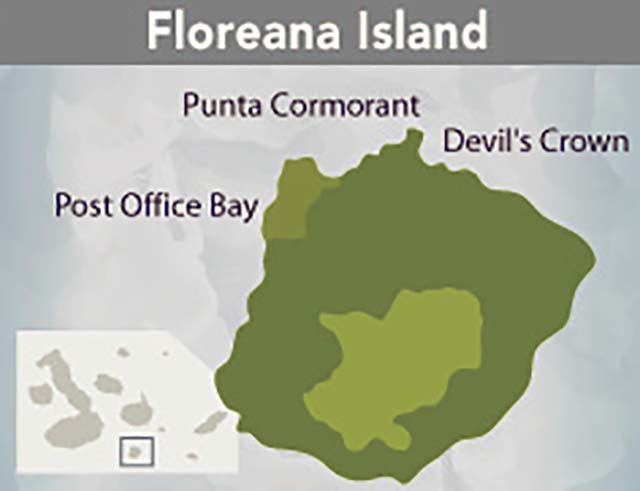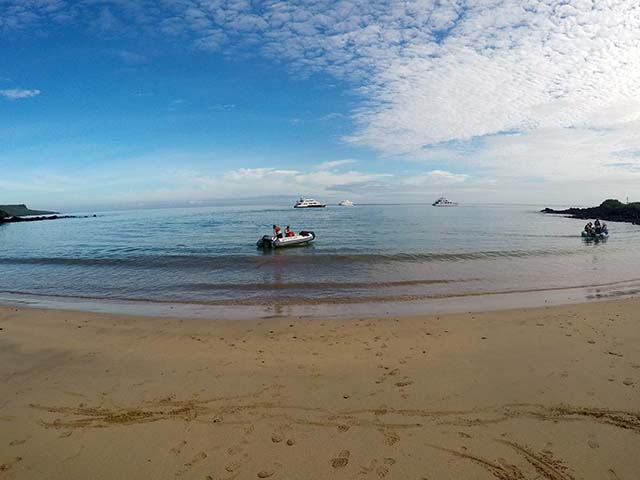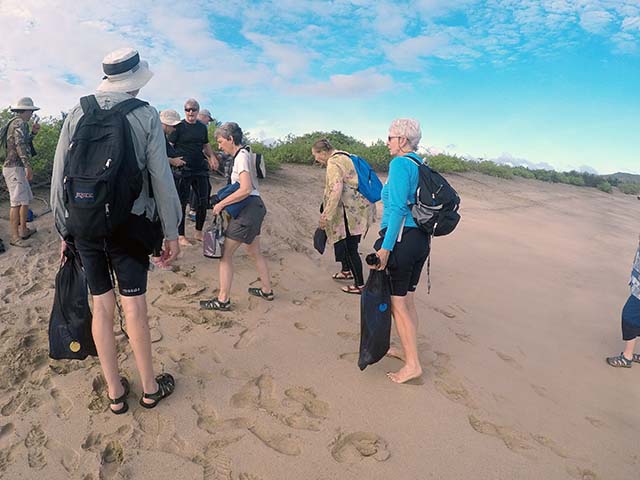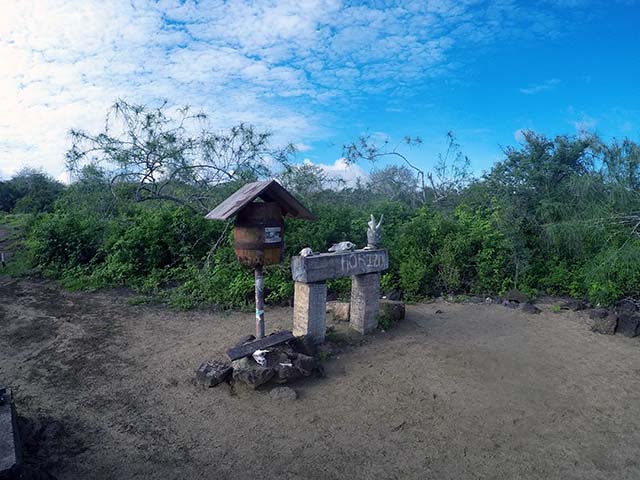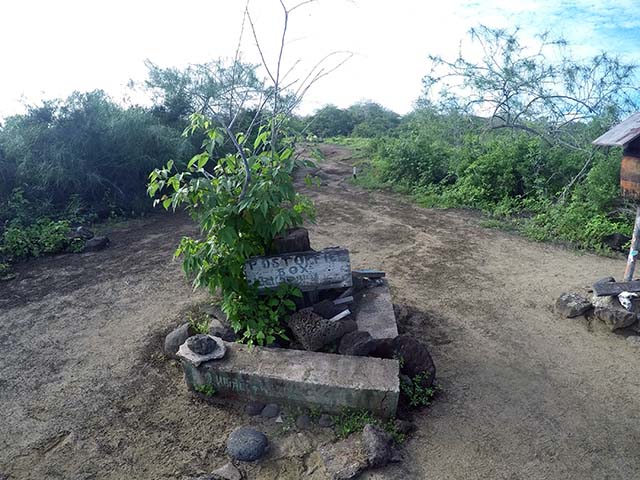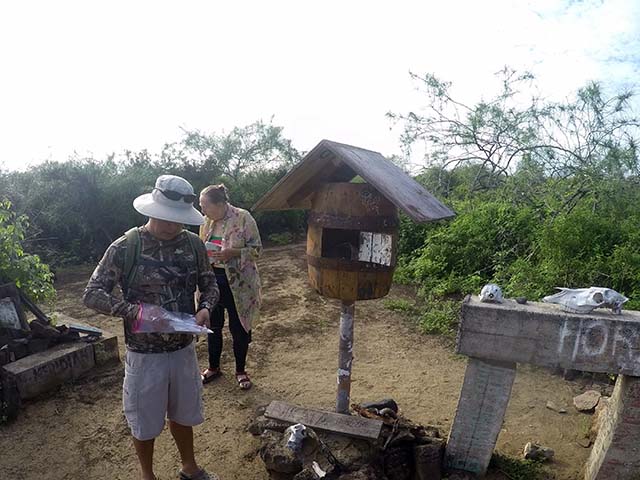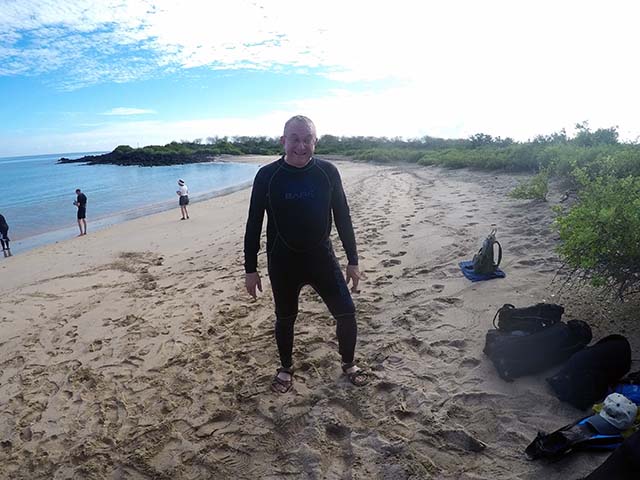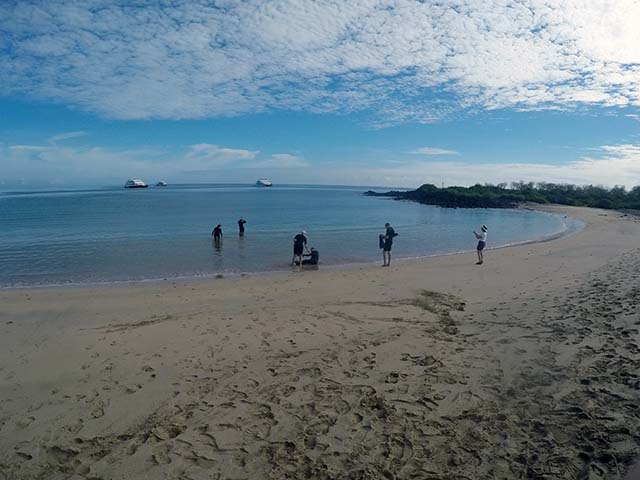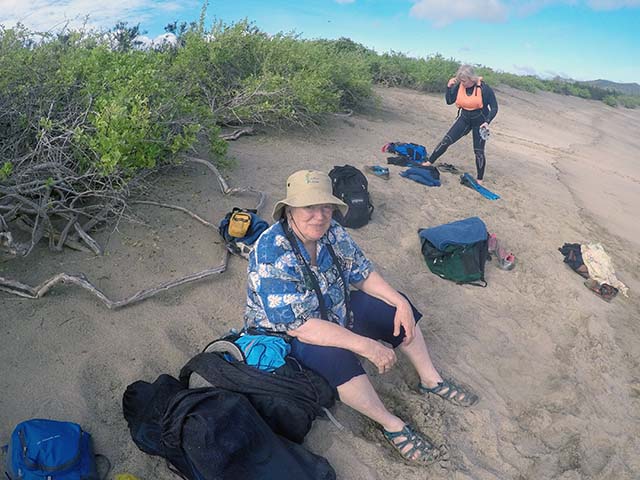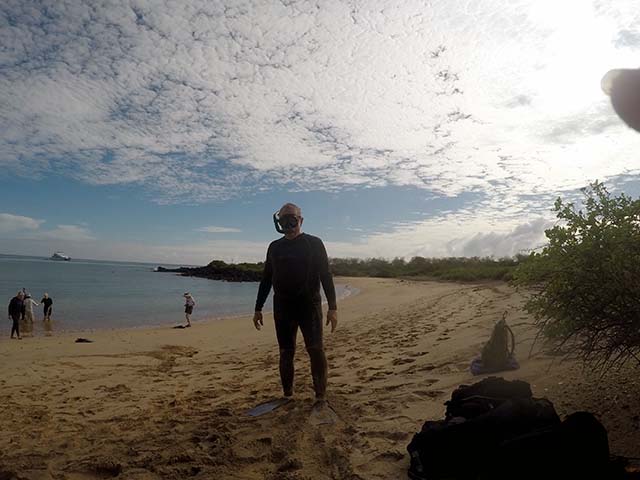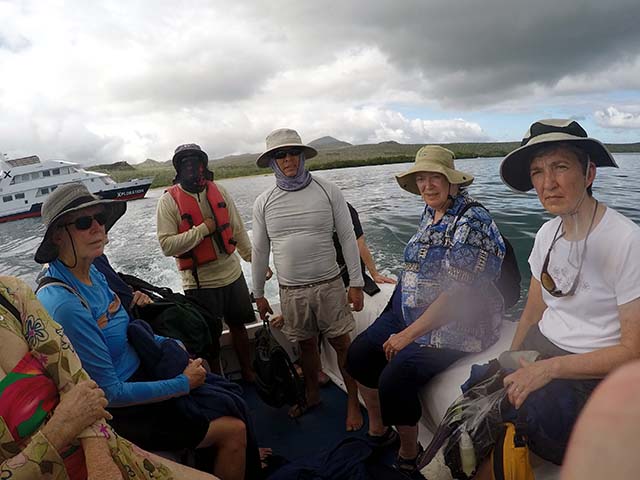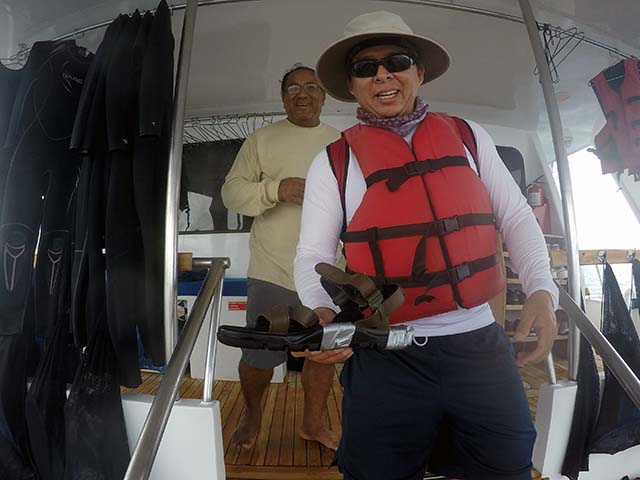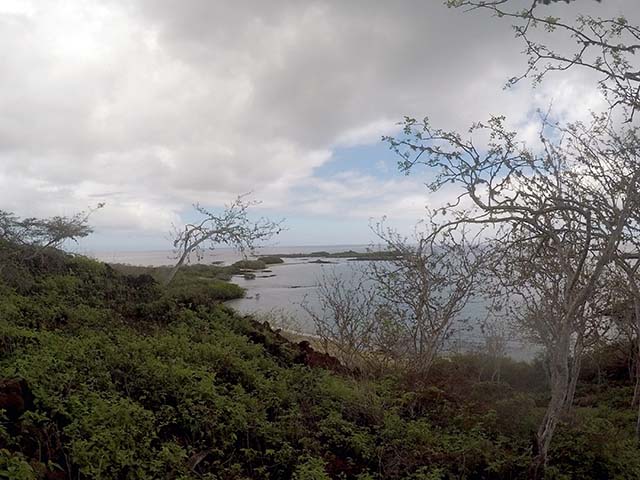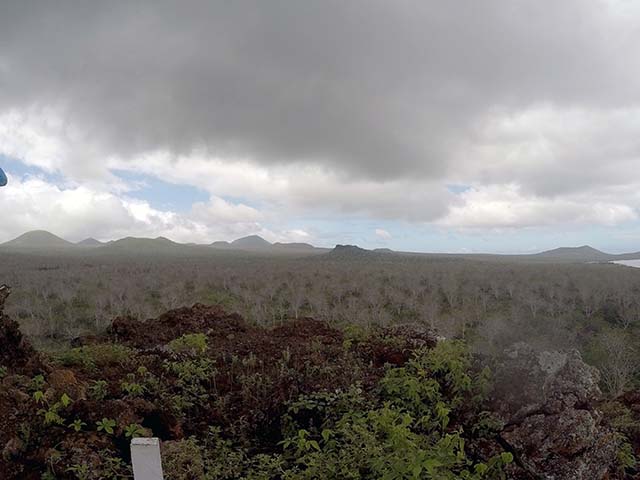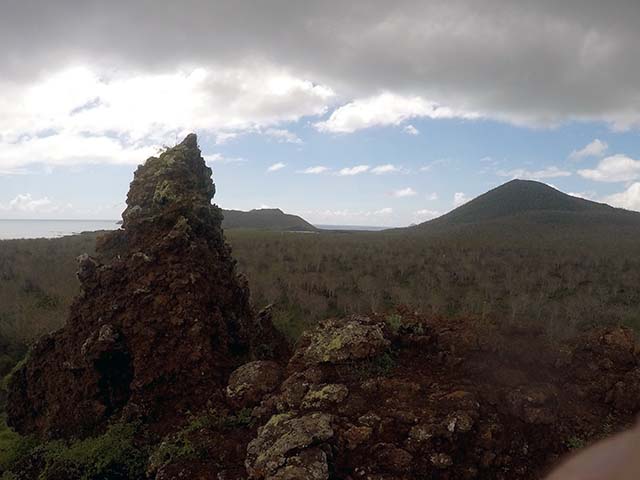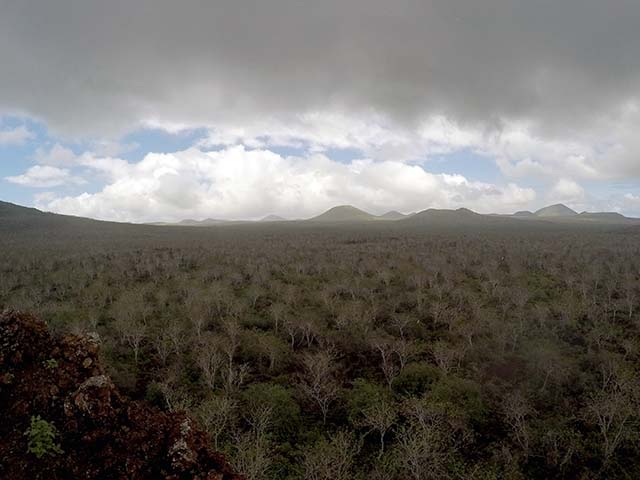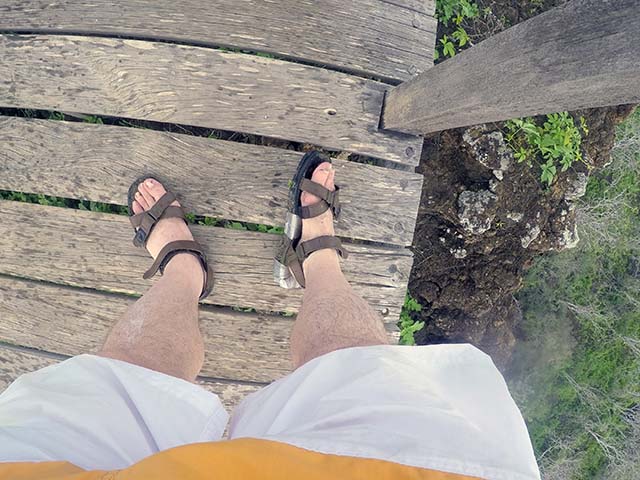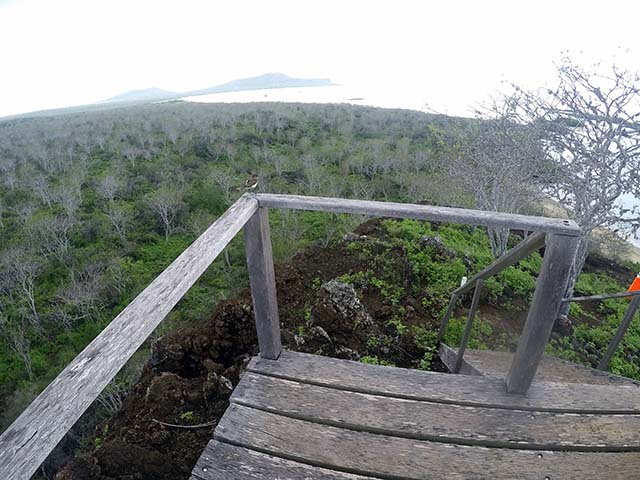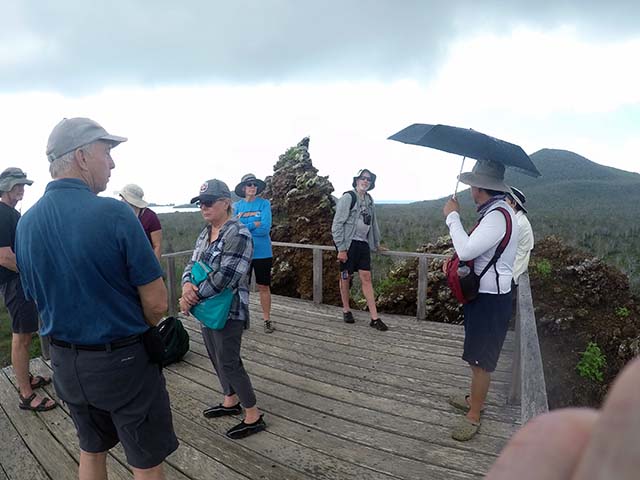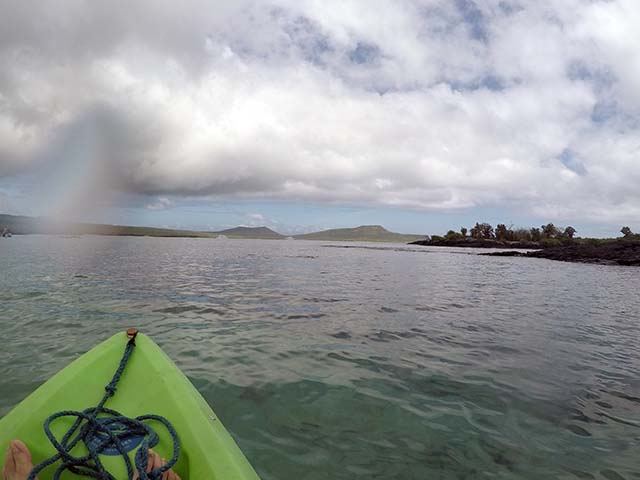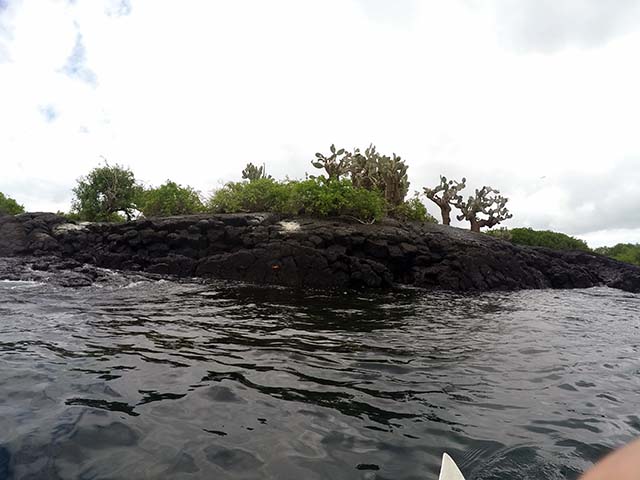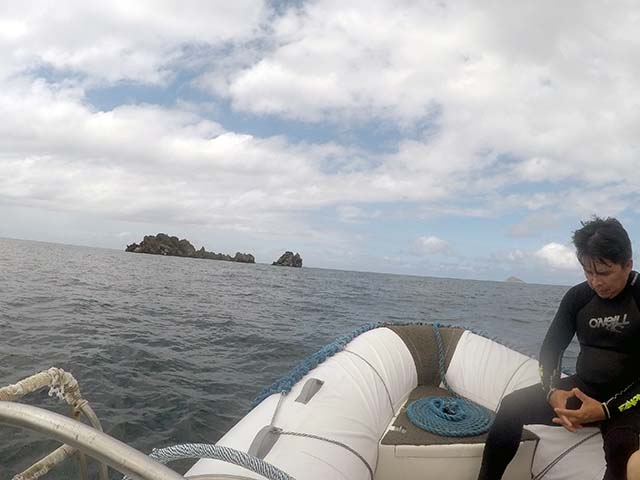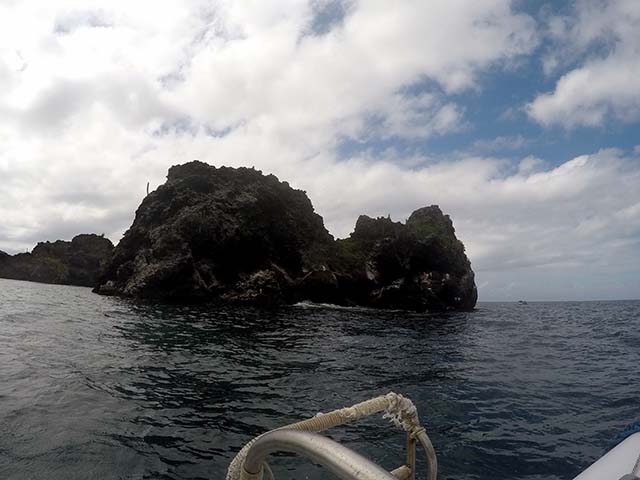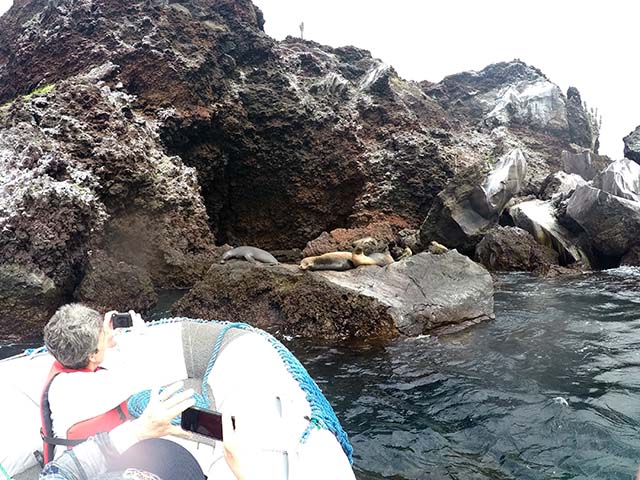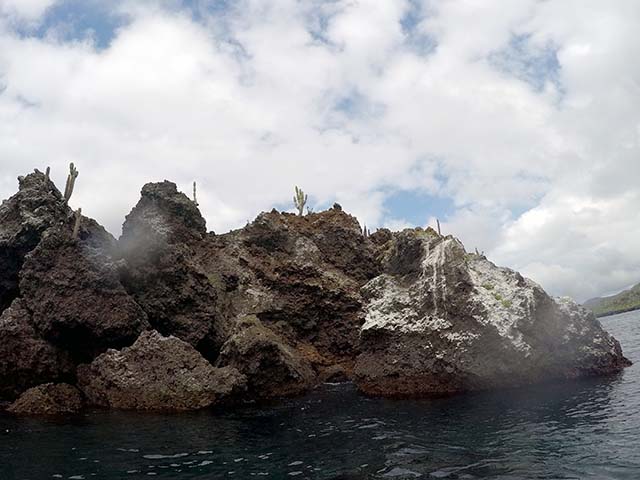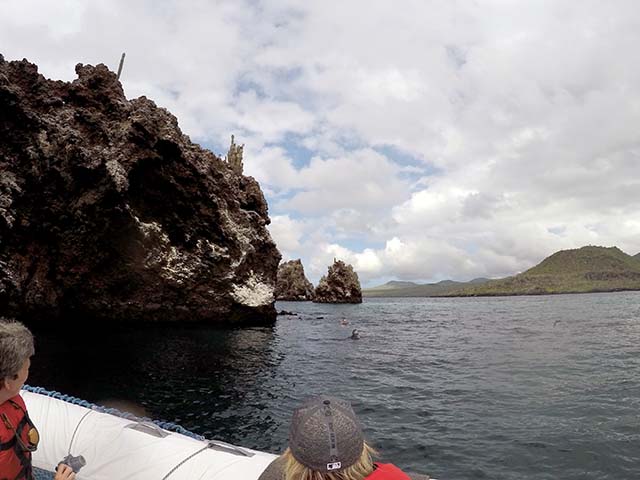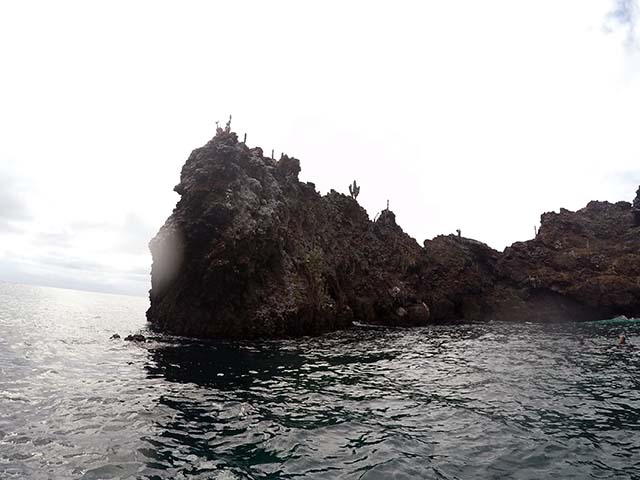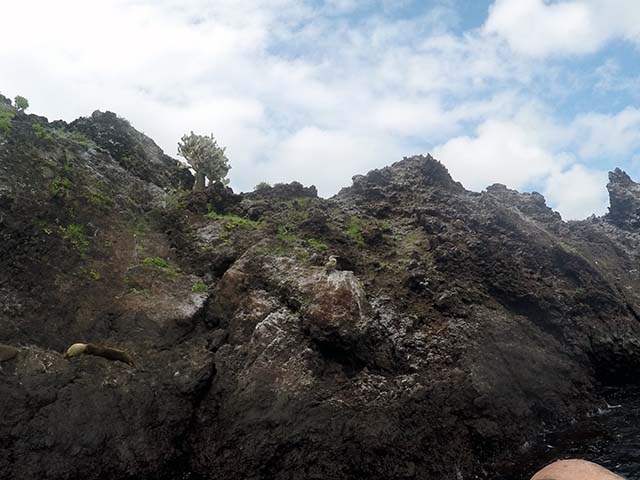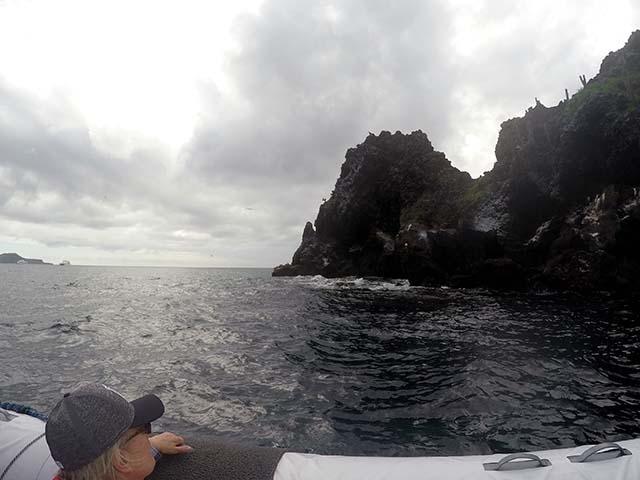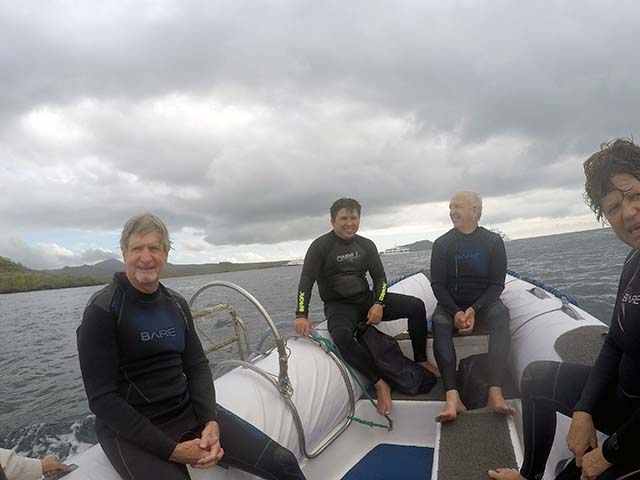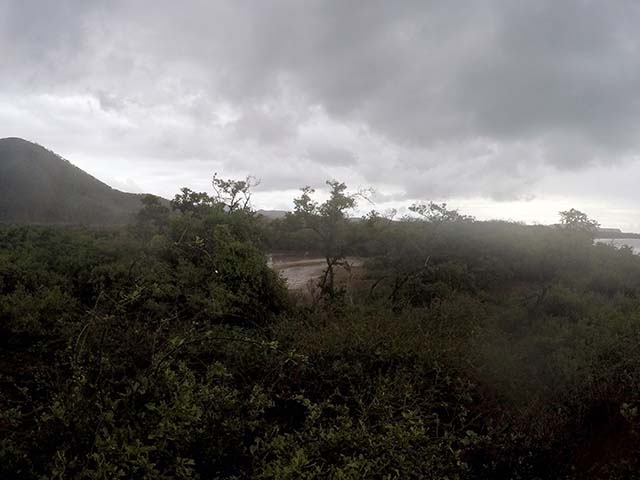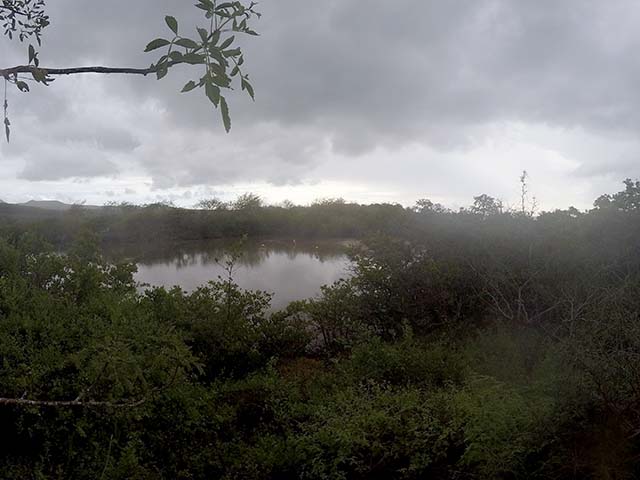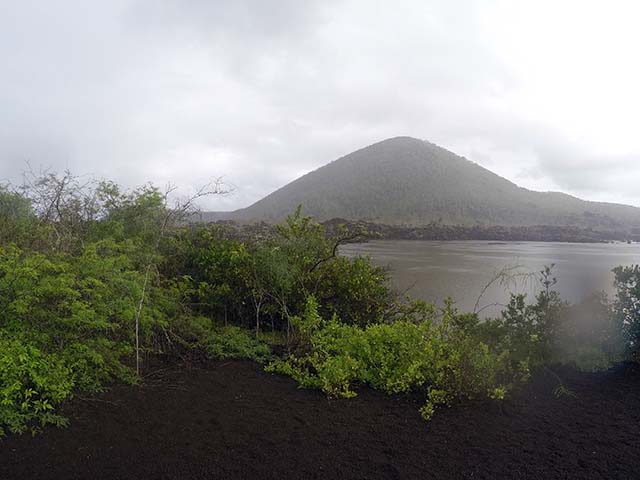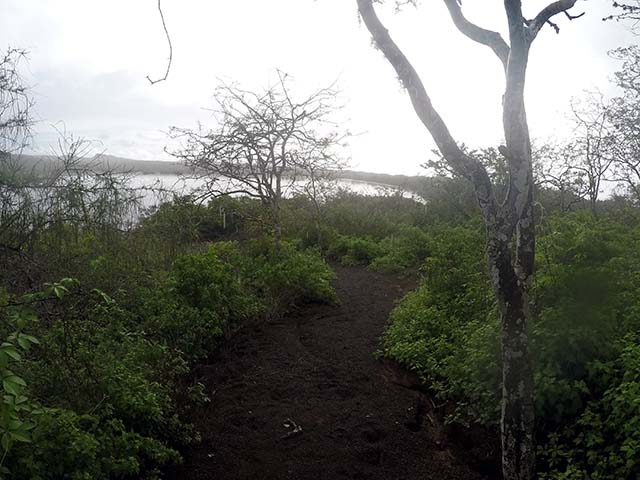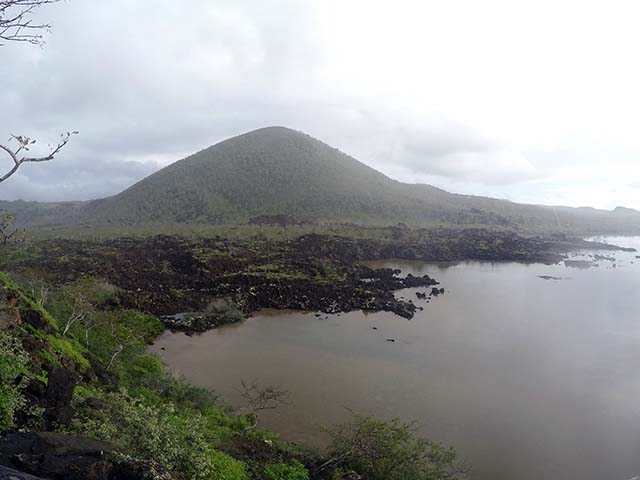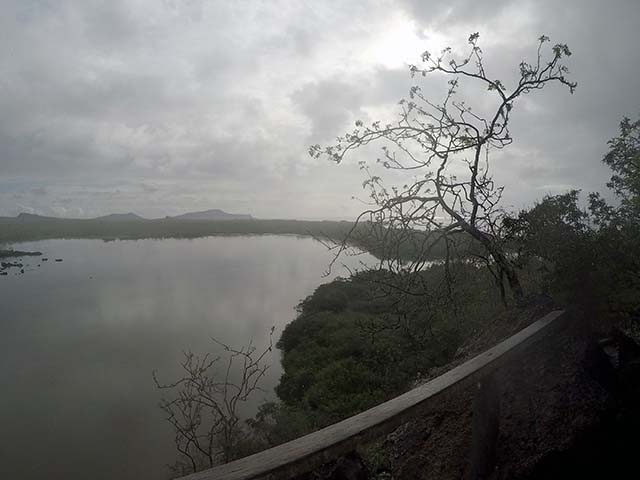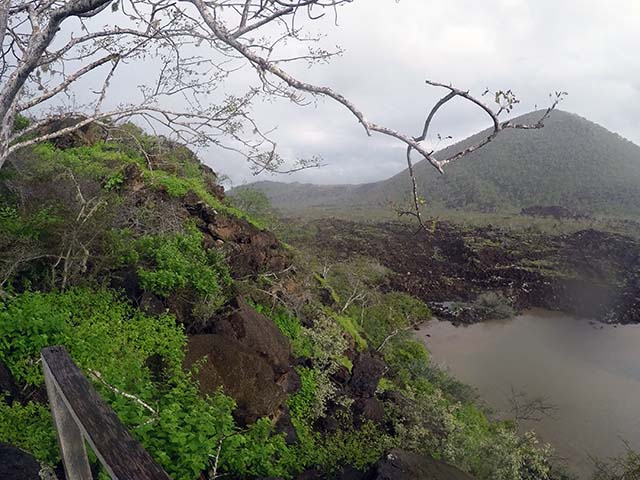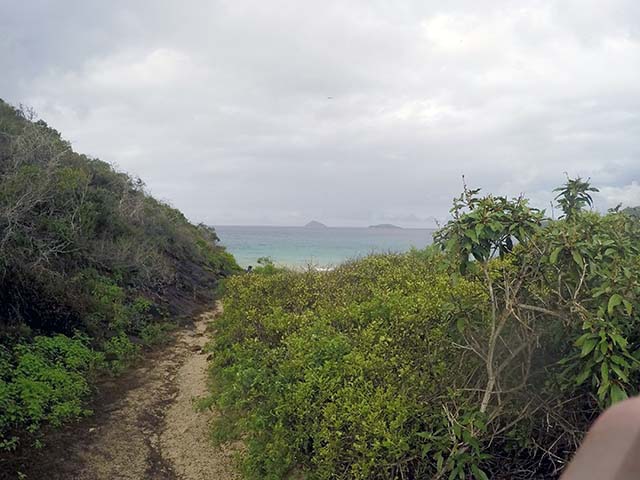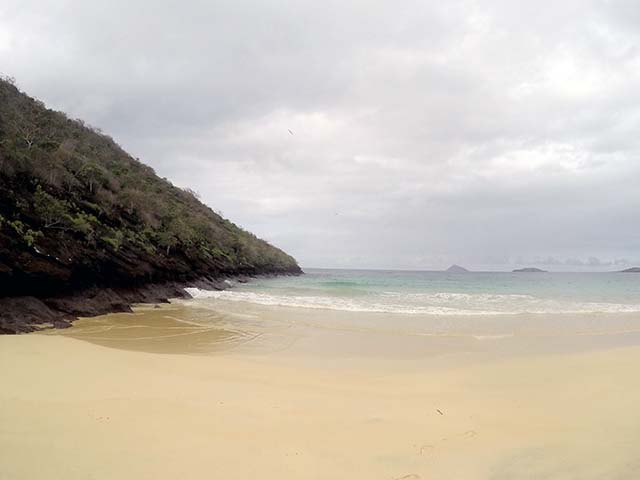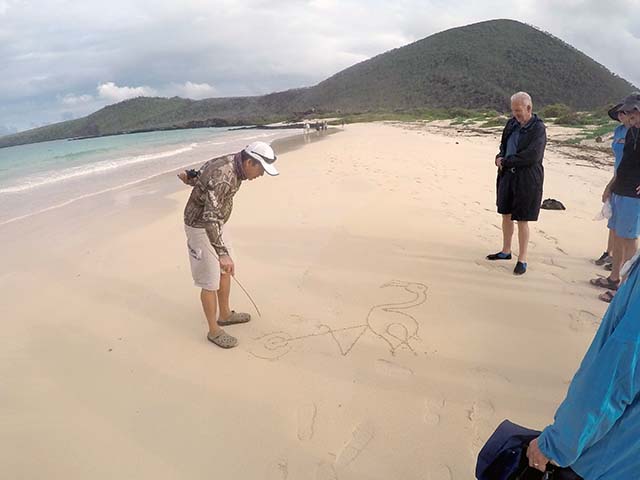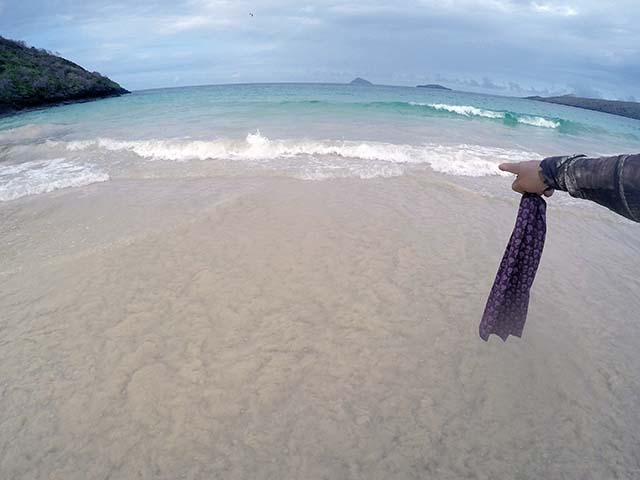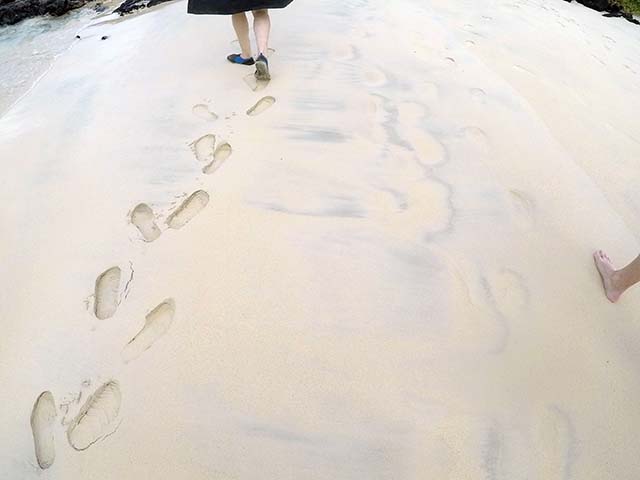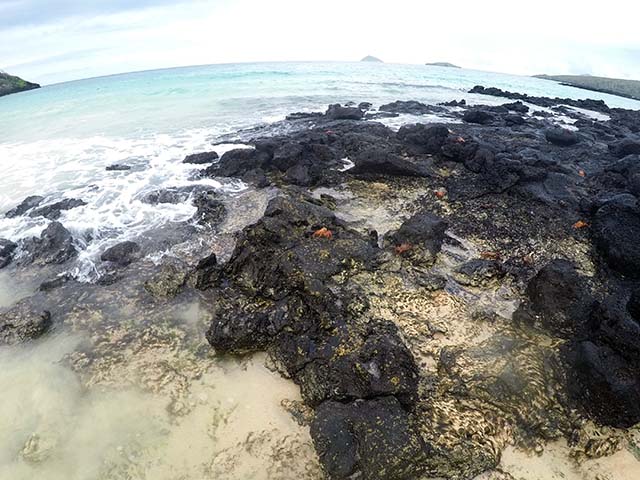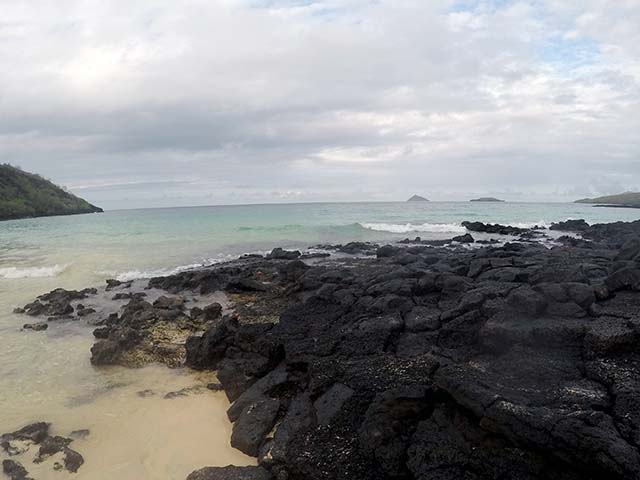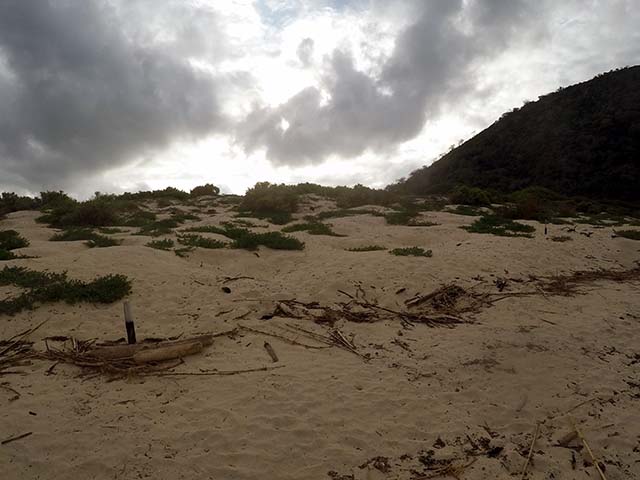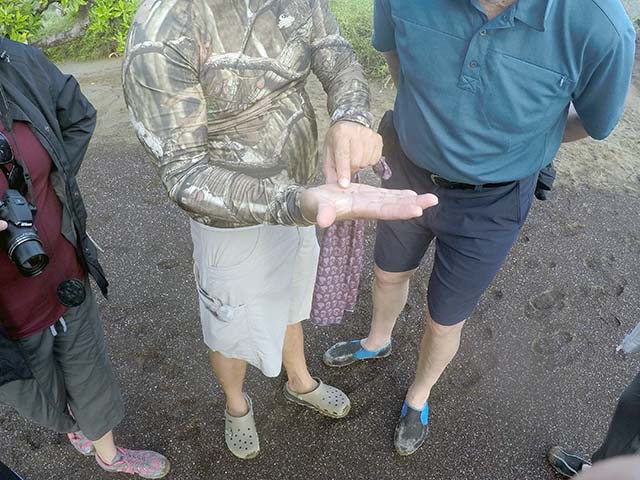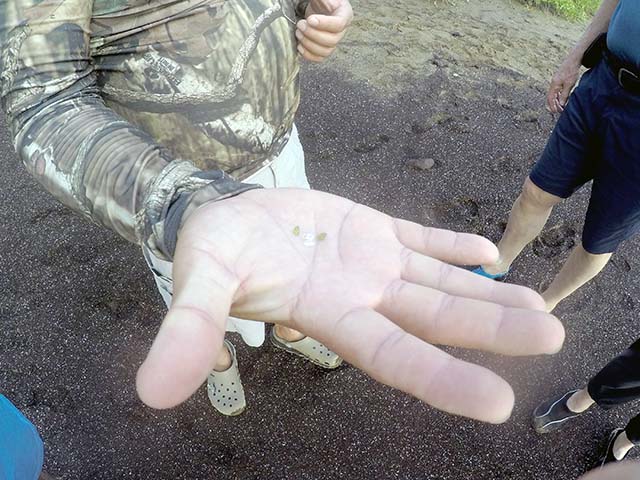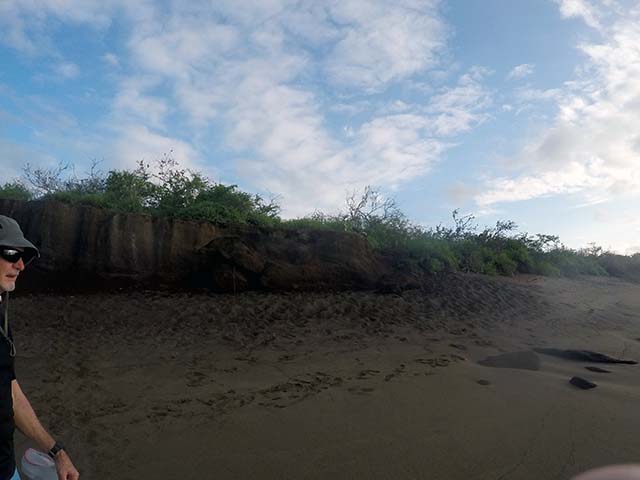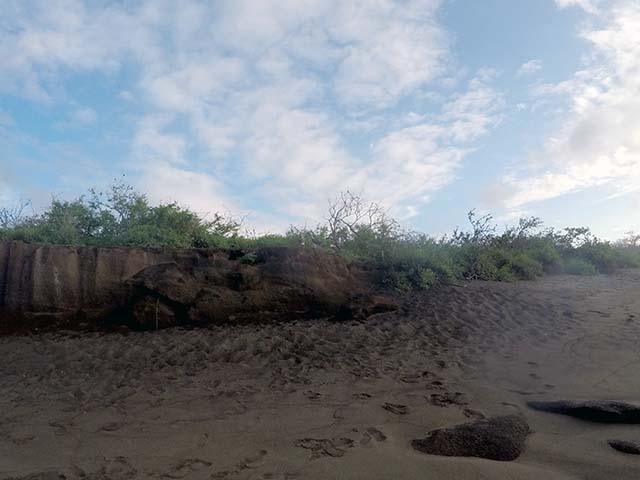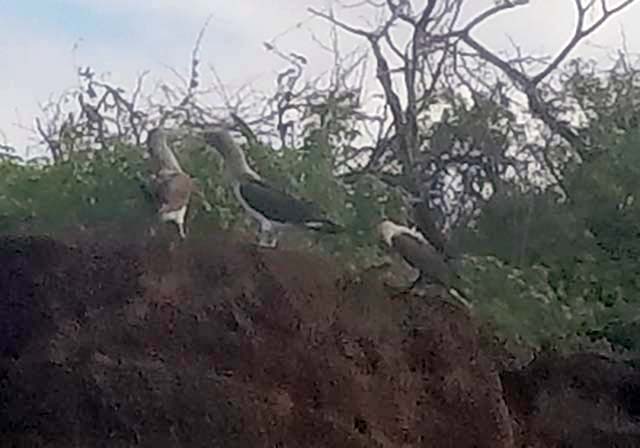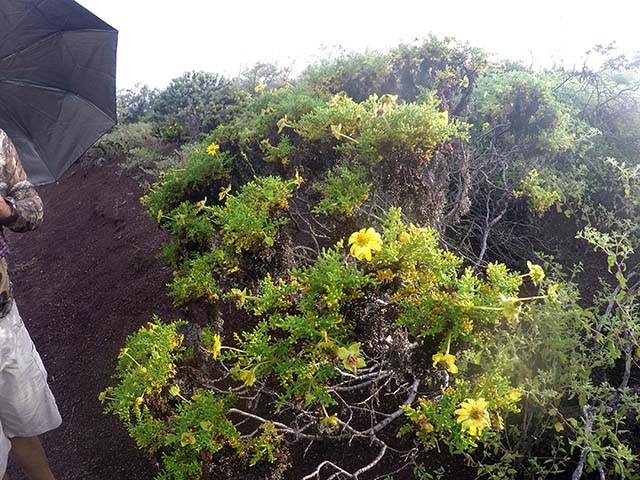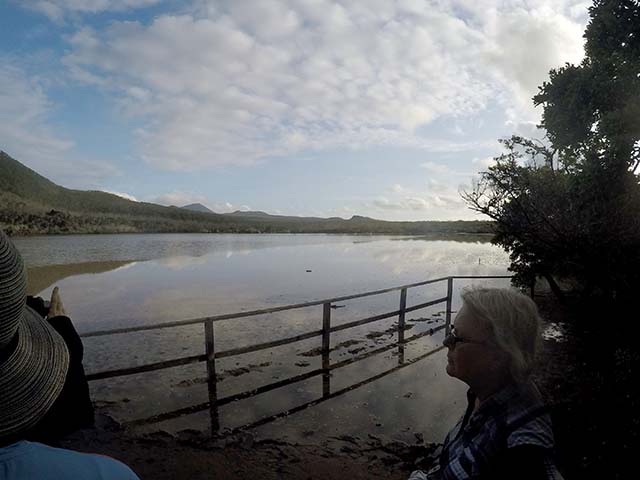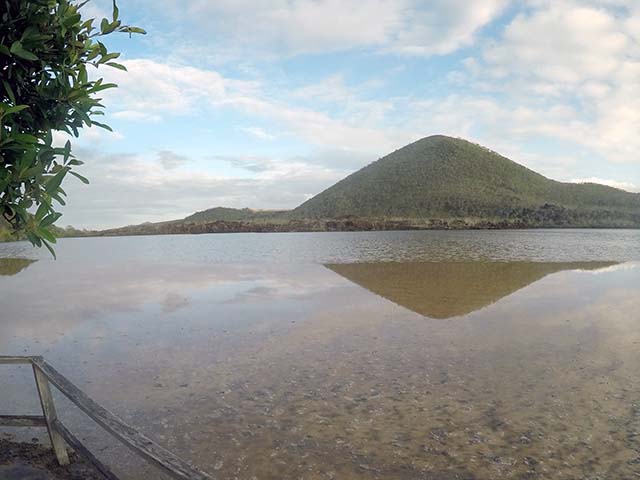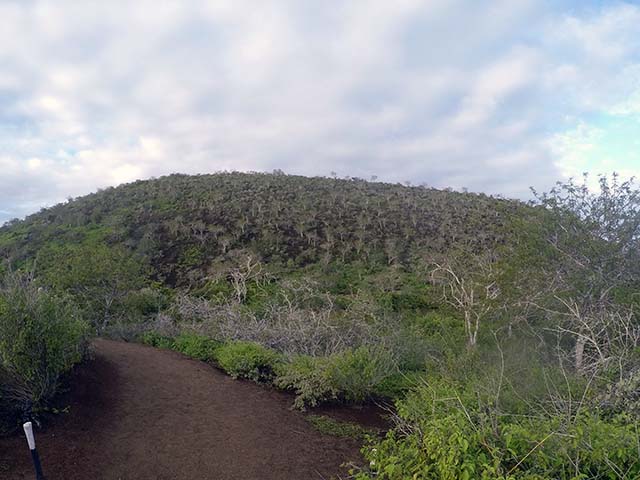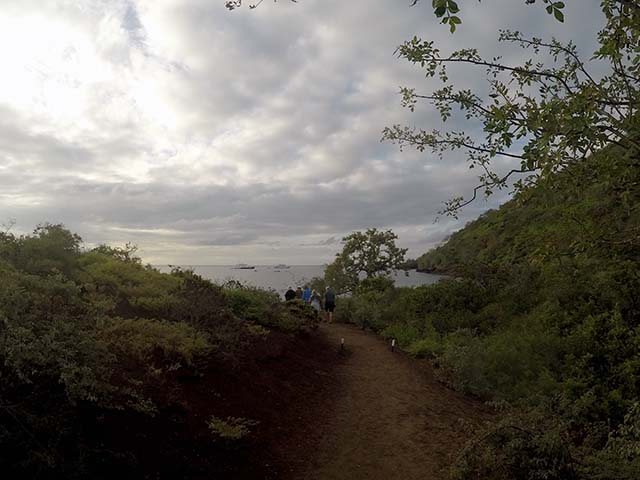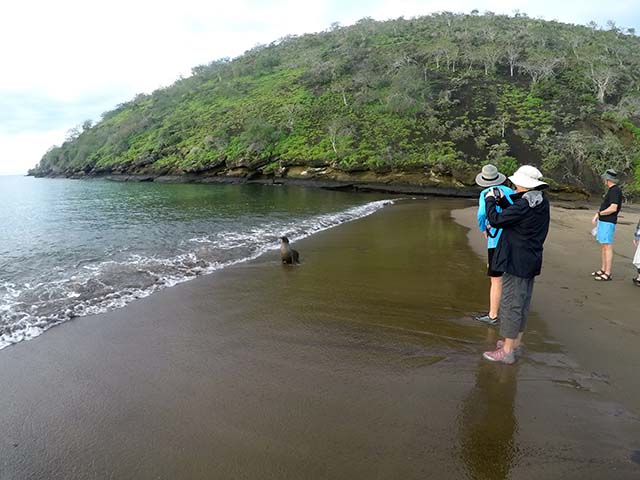|
Floreana Island is an island of the Galápagos Islands. It was named after Juan José Flores, the first president of Ecuador, during whose administration the government of Ecuador took possession of the archipelago. It was previously called Charles Island (after King Charles II of England), and Santa Maria after one of the caravels of Columbus. The island has an area of 173 square kilometres (67 sq mi). It was formed by volcanic eruption. The island's highest point is Cerro Pajas at 640 metres (2,100 ft), which is also the highest point of the volcano like most of the smaller islands of Galápagos. Since the 19th century, whalers kept a wooden barrel at Post Office Bay, so that mail could be picked up and delivered to their destination by ships on their way home, mainly to Europe and the United States. Cards and letters are still placed in the barrel without any postage. Visitors sift through the letters and cards in order to deliver them by hand. Due to its relatively flat surface, supply of fresh water as well as plants and animals, Floreana was a favorite stop for whalers and other visitors to the Galápagos. When still known as Charles Island in 1820, the island was set alight as a prank by helmsman Thomas Chappel from the Nantucket whaling ship the Essex. Being the height of the dry season, the fire soon burned out of control. The next day saw the island still burning as the ship sailed for the offshore grounds and after a full day of sailing the fire was still visible on the horizon. Many years later Thomas Nickerson, who had been a cabin boy on the Essex, returned to Charles Island and found a black wasteland: "neither trees, shrubbery, nor grass have since appeared." It is believed the fire contributed to the extinction of some species originally on the island. In September 1835 the second voyage of HMS Beagle brought Charles Darwin to Charles Island. The ship's crew was greeted by Nicholas Lawson, acting for the Governor of Galápagos, and at the prison colony Darwin was told that tortoises differed in the shape of the shells from island to island, but this was not obvious on the islands he visited and he did not bother collecting their shells. He industriously collected all the animals, plants, insects and reptiles, and speculated about finding "from future comparison to what district or 'centre of creation' the organized beings of this archipelago must be attached." In 1929, Friedrich Ritter and Dore Strauch arrived in Guayaquil from Berlin to settle on Floreana, and sent letters back that were widely reported in the press, encouraging others to follow. In 1932 Heinz and Margret Wittmer arrived with their son Harry, and shortly afterwards their son Rolf was born there, the first citizen of the island known to have been born in the Galápagos. Later in 1932, the self-described "Baroness" von Wagner Bosquet arrived with companions, but a series of strange disappearances and deaths (including possible murders) and the departure of Strauch left the Wittmers as the sole remaining inhabitants of the group who had settled there. They set up a hotel which is still managed by their descendants, and Mrs. Wittmer wrote an account of her experiences in her book Floreana: A Woman's Pilgrimage to the Galápagos. A documentary film recounting these events, The Galapagos Affair, was released in 2013. The demands of these visitors, early settlers, and introduced species devastated much of the local wildlife with the endemic Floreana tortoise being declared extinct and the endemic Floreana mockingbird becoming extirpated on the island (the few remaining are found on the nearby islands of Gardiner and Champion). When Charles Darwin visited the island in 1835, he found no sign of its native tortoise and assumed that whalers, pirates, and human settlers had wiped them out. Since about 1850, no tortoises have been found on the island (except for one or two introduced animals kept as pets by the locals), and the International Union for Conservation of Nature classified the Floreana tortoise (Chelonoidis elephantopus sometimes called Chelonoidis nigra) as extinct. However, it may be that there are pure Floreana tortoises living on other islands in the archipelago. Isla Floreana is a shield volcano, which has erupted alkaline basalts continuously since 1.5 Ma. It is the southernmost island in the Galapagos Archipelago, and a 3,400 m submarine escarpment 10 km south of the island forms the southern boundary of the Galapagos Platform. There are over 50 scoria cones onshore and 6 tuff cones offshore. Mostly composed of tephra, these cones are the origin of the A'a lava flows. The oldest flows are on the northern end of the island, while the youngest (26 ka) are on the southern end. Cerro Pajas is the origin of the largest lava flow (272 ka.
The boat did some traveling overnight, and now we're at Floreana Island where we'll do some snorkeling and exploring.
Bill is halfway in his wetsuit. Pssst...Bill. the zipper goes in the back. How did you ever get that thing on backwards? Pretty impressive, actually, but you're gonna have to pull it off and start over.
Wet landing on the beach at Floreana.
But before we snorkel, there's some business to take care of
What on earth is this?
A post office box? Way out here?
Yep, and Franklin is going to take care of Postmaster duties.
This really is a post office sorta kinda. You don't need a stamp. It's a tradition from the days of sailing ships when sailors would stop at a barrel on Floreana Island to pick up letters left by previous sailors, addressed to places they were planning to visit. The sailors would leave their own letters, and take letters they knew they could deliver. I put four postcards in the barrel. Someday four people I know may or may not receive delivery of a postcard by a total stranger. Time will tell. (The whole business with Franklin "stamping" the postcards was just fun, for show.) As for post card delivery, we went through the entire collection in the barrel, looking for addresses close to our homes. The closest I found was Birmingham, but others in our group actually found cards they could deliver when they got home. Fun! I sent four postcards. To whom, you ask? Well, I'd rather not disappoint anybody, so that'll remain my little secret. But don't be surprised if someday a sunburned stranger shows up at your door with a blue-footed booby postcard in his hand.
Nice, Bill. Fits better now, doesn't it?
Heading out to search for sea creatures.
Marilyn has decided to let others do all the work.
Stop straggling Bill, and get in the water.
Snorkeling off the beach. The surf made things a bit difficult, but there were pretty fish to be found.
Heading back to the Tip Top III for a brief rest before more snorkeling.
There's a story here. The reading materials Road Scholars sent me prior to the trip made it clear I'd need some "swimming shoes," something appropriate for wet landings on beaches, short hikes in the sand, etc. So I ordered some from Amazon -- Speedo brand, they were -- and while they were a little snug, they fit my feet at home. But somehow my feet got "all swole up" on the trip and I had to resort to plan B, an old pair of sandals I'd brought along just in case. They were good sandals, top quality, bought them at Nordstrom for the Hoppy Onnivussry cruise back in 1995. (My parents' 50th anniversary cruise in the Caribbean.) I stuck them in my bag as an afterthought, just in case. And they worked fine for one outing, at least until the sole separated. Oh no, what shall I do? Answer: Duct Tape. Of course. That did the job for the rest of the trip and then I asked permission to leave them behind. My poor Duct Tape sandals are still roaming the Galapagos Islands, as far as I know. Wonder what natural selection will make of them?
More hiking on Floreana, now in my Duct Tape sandals.
This navigation light looked particularly orange among the more drab vegetation.
Apparently all those trees had leaves a few months ago.
Not much in the way of greenery on this end of Floreana today.
But there is a beauty to it.
Oh yeah, this was the day that only one sandal was Duct Taped. The other one would fall apart tomorrow.
It's a very nice overlook tower, called "Baroness Viewpoint," apparently, and oh, look on the rail! It's a bird! Lots of unusual birds live in the Galapagos Islands. Darwin finches are of particular interest, as changes in their beak sizes and other characteristics caused by natural selection can be measured over relatively short periods.
It's rainy and we're getting ready to go back down. This is where my Duct Tape sandal slipped on a rock at the bottom of the stairs and I took a tumble into some sharp volcanic stones and a sticky-leaf bush. The rocks just scraped my elbow, but the sticky leaves did lasting damage to my T-shirt. I did my best to pull them off, but Franklin says some of the remnants will be be with the shirt until old age.
We went kayaking in a cove for a little while. I never quite understood why.
David and I paddled around a bit and my back and legs began to ache. Of all the fun things we did on the trip, this was the least of them.
Look. Volcanic rock.
Now we're headed out to the Devil's Crown for some "Rambo snorkeling," as Franklin put it.
Devil’s Crown is a volcanic crater that has been eroded away by the waves, with a few rocky spikes protruding above the water in a semicircular pattern. Inside the crown, snorkelers find an underwater oasis of coral reefs and the marine species that are attracted to them, such as playful sea lions, colorful King Angel Fish, Balloon Fish, hawkfish, Yellowtail grunts, Tiger Snake Eels, White-tipped Sharks, Eagle Rays, amberjacks, wrasses, Hammerhead Sharks, and sea turtles. The rocky remains of the volcano create a haven for seabirds such as boobies, pelicans, and frigatebirds. Red-billed Tropicbirds nest in the crevices. The water is a bit rough and the current is strong. Strong swimmers can swim through a tube on the western side (approximately 4-5 m down) and come out on the other side. The problem was, I wasn't really mentally prepared for what we were doing and when I hit the water I began hyperventilating and pretty soon had to climb back in the boat, which left me puzzled. I can swim, I can snorkel...so what went wrong? I guess I'll never know, as the next day I got a grip and did just fine.
But today I just rode around in the dinghy waiting for others to finish snorkeling. Look! Sea lions!
The things you see from a dinghy in the Galapagos Islands.
Don't forget cacti and bird poop!
Looks like the others are ready to get back in the boat.
I'll always have to wonder what I might've seen if I'd stuck with it here.
But I'll have to be content with sea lions and bird poop.
Bye Devil's Crown
Back to the boat to strip out of wet suits and ...
Another hike? You've got to be kidding.
There are flamingos over there in that pond.
I'm not kidding, there really are. Get your binoculars. You'll see.
It's a pretty setting.
But there were mosquitoes.
Even on a drizzly day it was pretty here.
And there were flamingos.
Somewhere.
Life takes hold in volcanic soil.
Let's hike to another beach.
Nice.
Franklin drew something in the sand. A flamingo. See? Told you they were here.
Franklin kept telling us he'd spotted rays swimming in the surf.
Footprints in the sands of time.
Oh look! Red crabs on black rocks. There were also black crabs, but they're harder to spot.
Red crabs, black rocks, seashore, and I never did see it, whatever it was.
When you're looking at one picture after another of this, it can get boring. But when you're there, it's actually very nice.
Neither flotsam nor jetsam. It's great that in the Galapagos Islands it's rare to see any trash but natural trash.
Franklin says, "Come look."
If you squint your eyes and hold your mouth right you'll notice that a lot of the sand on this beach has a greenish tint. The green tinge in the sand is due to the large amount of olivine crystals that have been expelled from nearby tuff cones by the wind. A tuff cone is a type of volcanic rock which is formed by the interaction of basaltic magma (molten volcanic rock beneath the surface of the earth) and water.
We saw at some distance these blue-footed boobies showing off their feet to each other high up on a cliff. Sorry about the shaky-cam, but I did the best I could with the GoPro and then zoomed in on the birds with computer software when I got home. They do appear proud of themselves, don't they. The guy is the one with his tail stuck straight up. The blue-footed booby (Sula nebouxii) is a marine bird native to subtropical and tropical regions of the Pacific Ocean. It is one of six species of the genus Sula – known as boobies. It is easily recognizable by its distinctive bright blue feet, which is a sexually selected trait. Males display their feet in an elaborate mating ritual by lifting them up and down while strutting before the female. The female is slightly larger than the male and can measure up to 90 cm (35 in) long with a wingspan of up to 1.5 m (5 ft)
See how far away we were?
It was hard to get a good shot.
But with the magic of PhotoShop magnification, you can get an idea of what was going on.
That's a Galapagos daisy bush.
And here we are passing the flamingos again. They were even harder to spot this time.
But the scenery was still pretty
And barren
Ah, the beach at last. We'll have it all to ourselves as we wait for the Tip Top III dinghy.
Well, pretty much all to ourselves.
|

